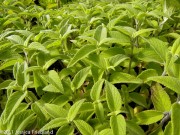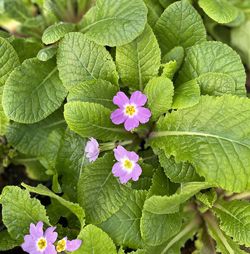
Salvia
Sage
Thought in ancient times to perpetuate good health, an Arab proverb asks, “How shall a man die with sage in his garden?” Our Salvias are diverse perennials, shrubs or subshrubs, many hailing from the Mediterranean, Mexico, South America and some of our western states. Reliable once established, and generally undaunted by pests, disease and drought, they combine an array of flowers and often aromatic foliage in many different sizes, shapes and hues.
Each 11.75

Hailing from the cool highlands of Guatemala and Chiapas, Mexico, this vigorous Salvia volunteers hundreds of brilliant cardinal red, whorled blossoms in late fall. A yellow-green cast infuses young growth while mature leaves are darker green. Marked by light green grooves, the numerous, wine-infused lax stems become obscured by prominently veined triangular leaves, which taper to pronounced narrow tips.
Paying homage to Edward Holway, an American mycologist and plant collector who traveled to Mexico in the early 1900s, Salvia holwayi blooms all winter long in warmer areas, gracing its lush and bushy good-sized mass with much appreciated color and hummingbird food.
Grateful for a well drained, humus rich spot and a hard cut after blooming, it creates a verdant backdrop for the mixed border, an excellent conservatory plant in colder climates and a splendid long lasting cut flower when they’re aren’t many others around.
Blooms October–December.
Size: 4' 0" high x 4' 0" – 6' 0" wide.
Hardy to zone 9.
Please fill out our Registration Form to receive news of updates to the web site, availability of new plants, give us your feedback, and to be on the mailing list to receive future printed catalogs.
Other selections in this genus:
- Salvia x ‘Allen Chickering’
- Salvia argentea
- Salvia arizonica
- Salvia azurea ‘Grandiflora’
- Salvia azurea ‘Nekan’
- Salvia ‘Bee’s Bliss’
- Salvia x ‘Big Swing’
- Salvia brandegeei ‘Pacific Blue’
- Salvia cacaliifolia
- Salvia chiapensis
- Salvia clevelandii ‘Whirly Blue’
- Salvia clevelandii ‘Winnifred Gilman’
- Salvia confertiflora
- Salvia corrugata
- Salvia ‘El Cielo Blue’
- Salvia ‘Eveline’
- Salvia forsskaolii
- Salvia glechomifolia
- Salvia greggii ‘Lowry’s Peach’
- Salvia x ‘Nuevo Leon’
- Salvia greggii ‘Wild Thing’
- Salvia guaranitica ‘Black and Blue’
- Salvia guaranitica ‘Blue Ensign’
- Salvia involucrata ‘Hidalgo’
- Salvia involucrata ‘Mulberry Jam’
- Salvia x jamensis ‘Pat Vlasto’
- Salvia leucantha x elegans ‘Anthony Parker’
- Salvia ‘Madeline’
- Salvia melissodora (Yucca Do Form)
- Salvia mexicana ‘Compton’s Form’
- Salvia mexicana ‘Limelight’
- Salvia mexicana ‘Tula’
- Salvia microphylla
- Salvia microphylla ‘Dennis’ Pink’
- Salvia microphylla x greggii ‘Red Velvet’
- Salvia microphylla ‘Hoja Grande’
- Salvia microphylla ‘San Carlos Festival’
- Salvia microphylla ‘Wild Watermelon’
- Salvia moorcroftiana ssp. x indica
- Salvia nemorosa ‘Amethyst’
- Salvia nemorosa ‘Blue Marvel’
- Salvia nemorosa ‘Caradonna’
- Salvia nemorosa ‘Midnight Rose’
- Salvia nemorosa ‘Negrito’
- Salvia nemorosa ‘Rosenwein’
- Salvia nemorosa ‘Sensation Deep Rose’
- Salvia nemorosa ‘Wesuwe’
- Salvia nemorosa ‘Schwellenburg’
- Salvia nubicola
- Salvia nutans
- Salvia ‘Phyllis Fancy’
- Salvia ‘Pozo Blue’
- Salvia pratensis ‘Sky Dance’
- Salvia pratensis ‘Swan Lake’
- Salvia pratensis ‘Sweet Esmeralda’
- Salvia pratensis ‘Twilight Serenade’
- Salvia przewalskii
- Salvia ‘Purple Majesty’
- Salvia purpurea ‘Lavender Lace’
- Salvia reptans
- Salvia reptans ‘West Texas Form’
- Salvia sclarea ‘Vatican White’
- Salvia semiatrata
- Salvia ‘Silke’s Dream’
- Salvia sinaloensis
- Salvia x sylvestris ‘Dear Anja’
- Salvia x sylvestris ‘Tanzerin’
- Salvia uliginosa
- Salvia ‘Ultra Violet’
- Salvia urica
- Salvia vanhoutii (Burgundy Form)
- Salvia verticillata ‘Purple Rain’
- Salvia ‘Waverly’











